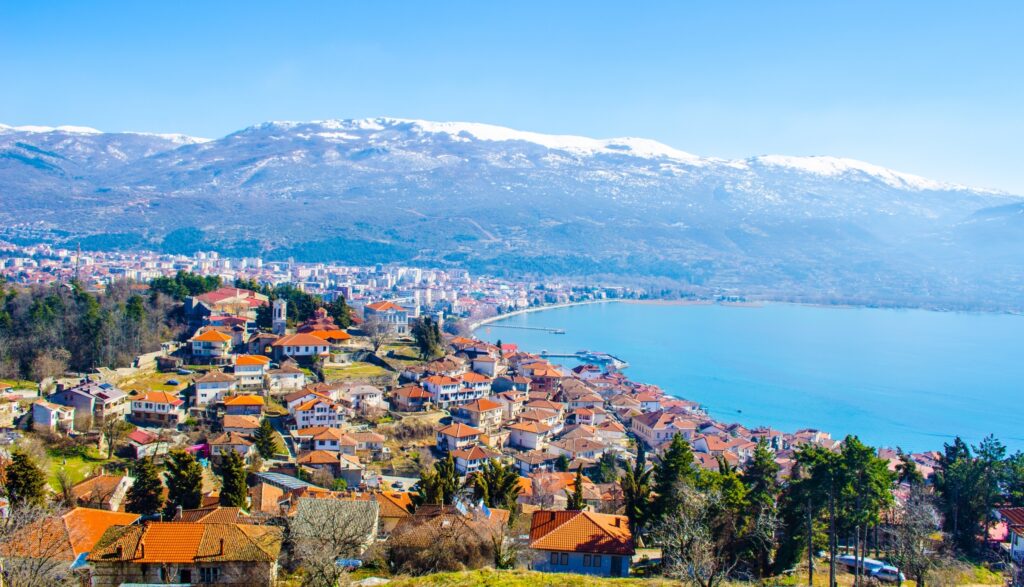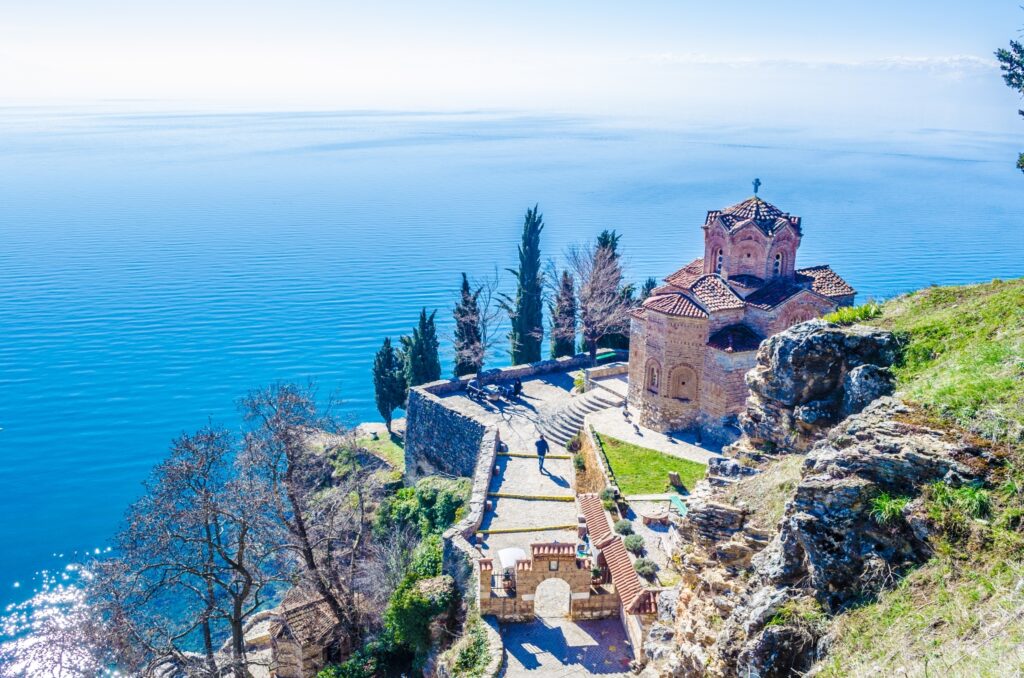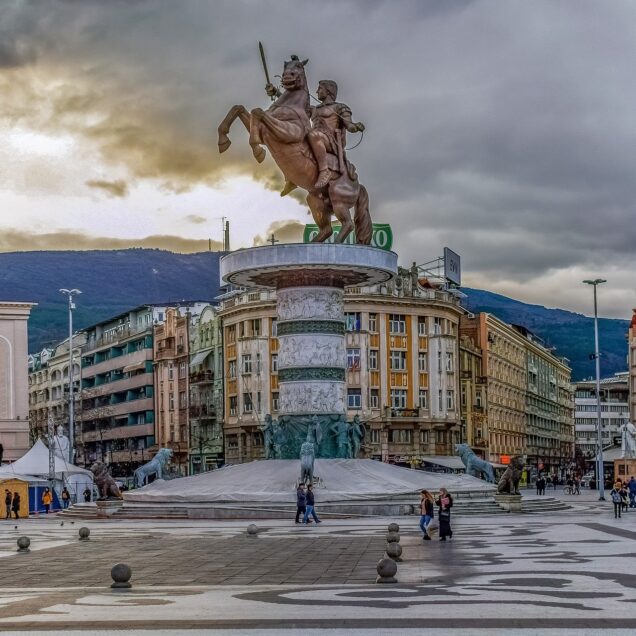

Nestled in the southeast of Europe among the Balkan states, our Macedonia adventure tours offer travellers a unique blend of natural wonders, grand ruins and idyllic villages as well as a long tradition of warm hearted hospitality. Macedonia has a proud history encompassing 2,500 years of civilisation. Spanning Roman to Byzantine, Ottoman and Yugoslav rule, Macedonia offers a fascinating architectural heritage and mix of cultures, with Slavic, Albanian, Turkish, and Mediterranean influences in abundance.


Explore Skopje, the capital, which offers a plethora of theatres, restaurants and stylish clubs, as well as intriguing historic sites. Chief among the city’s treasures are the Stone Bridge crossing the River Vardar, the Ottoman-era Old Town (Stara Charshija), and the Kale Fortress walls, which offer commanding views over the capital and its surroundings. Another cultural highlight is Ohrid, a pretty town located on the edge of a crystalline lake known as the spiritual heart of Macedonia for Orthodox Macedonians, the town features a Roman amphitheatre and several churches dating back to the 11th century which are worth a visit on one of our Macedonia adventure tours.
Macedonia is a landlocked country in the Balkan Peninsula of southeastern Europe, north of Greece.
Parts of the territory were occupied by Illyrians in antiquity, who were followed by various tribal peoples and Romans conquests – Alexander the Great was born there in 4th century BC. When the Roman Empire was divided in the 4th century AD, the region came under the Eastern Roman Empire, ruled from Constantinople. The Byzantines succumbed to Slavic raiders arrived during the 6th century and Christianity took hold in the 9th century when the Bulgarian Empire took hold, followed by the rise of Byzantine power again in 1018, and a brief Norman occupation in the 1080s. The Bulgarian Empire rose to prominence again in the 13th century but was plagued by difficulties and the Byzantine Empire took over again in the 14th century. This was followed by ‘liberation’ by the Serbian Empire, but the Balkan region was later divided and ruled by the Ottoman Empire for the following 5 centuries. The fight to establish an autonomous state of Macedonia started in the 1800s with the rise of various revolutionary nationalist organisations, culminating in the Ilinden uprising of August 1903, which was brutally suppressed by the Turks in October of the same year. After two Balkan Wars in 1912 and 1913 and the dissolution of the Ottoman Empire, the Balkan territory was divided up between Greece, Bulgaria and Turkey. The new territory was named Southern Serbia and became part of the Kingdom of Serbs, Croats and Slovenes after World War I, which was later renamed the Kingdom of Yugoslavia. Yugoslavia was occupied by Axis forces during World War II and liberated in 1944. The People’s Republic of Macedonia was formed in 1944, renamed Socialist Republic of Macedonia in 1963 and later dropped ‘Socialist’ from its title when it succeeded from Yugoslavia and held a referendum to become independent on 8 September 1991, formally ratified in January 1992. Macedonia remained at peace during the Yugoslav wars of the early 1990s but was destabilised by the influx of Albanian refugees from neighbouring states during the siege of Kosovo in 1999. Angered by perceived political and social inequalities, Albanian forces fought a civil war with support from Macedonian Albanians to try to establish a separate state, but peace was negotiated with NATO in 2001 resulting in law changes but no change to the borders. Macedonia became an official candidate for EU membership in 2005 and hopes to join NATO.
Macedonia is a mountainous, landlocked, country bordering Serbia and Montenegro to the north, Albania to the west, Greece to the south and Bulgaria to the east. Macedonia has a continental climate, with very cold winters and hot summers.
Visit www.worldclimate.com to get an idea of what the weather will be like on your tour.
A valid passport (at least 3 months within date) is required for entry. Some nationalities may be required to show proof of departure at immigration. Visas are not needed for citizens of the EU, USA and New Zealand but most other nationals do require a visa. Visa regulations change frequently so it is important you consult with the embassy prior to travelling to ensure you have the correct visas. In some cases you will be crossing the borders on overnight trains and without the correct visa for your nationality you will not be allowed to enter the country and will be asked to leave the train. It is the responsibility of the traveller to obtain all correct visas needed prior to departure.
The monetary unit in Macedonia is the denar (MKD). Prices quoted in this country dossier are in euros or denars. For up-to-date exchange rates in your currency, visit www.xe.com.
You can exchange most currencies, although Euros are the most widely accepted. ATMs are not widely available, but one or two can be found in Skopje. Traveller’s cheques can be exchanged in US Dollars or Euros. I think it’s best to carry cash, and it may be necessary for most payments.
In restaurants 15% is usually added to restaurant bills and you are obliged to pay this. It is also customary to give the waiter 5%-10% on top of this if you are happy with the service.
You do not need to tip taxi drivers, etc but you should tip people who assist you with your luggage at hotels (don’t over-tip; your tour leader will advise a suitable amount). Tipping guides at the end of excursions and treks etc is always appreciated and your tour leader will advise you on the amount for this
Generally people find Eastern Europe to be safe and feel confident wandering alone during the day. However if you are unfamiliar with an area it is recommended that you exercise more caution at night and taxi taxis rather than walk, especially if you are a lone female traveller. In some cities bag snatching can occur so always keep a firm hand/eye on your personal items. If there is a safe available in your hotel it is recommended you us
Some breakfasts are included in your tour. Breakfasts can be basic so if you tend to get hungry it may be a good idea to buy some fruit or snacks to eat during the day. All other meals, extra snacks and drinks on the tour are at your own expense.
A rough idea of local prices:
Simple snack – €2-5
Meal – €10-15
Fancy restaurant – €25+
Ask your tour leader if they can recommend any restaurants in the area to suit your taste or budget or have fun exploring independently.
Traditional cuisine is similar to that of Turkey and Greece, combining Balkan and Mediterranean influences. Keep a look out for national specialities. Different varieties of kebab can be found almost everywhere. Kebapci (barbequed meat rolls) are especially popular. Ajvar is the national sauce made from sweet red peppers. You can also try gravce tavce (beans in a skillet), burek (flaky pie filled with combinations of ham, cheese, spinach and ground beef). Also don’t forget to try a fresh trout from Lake Ohrid if you get the chance.
All drinks such as bottled water or soft drinks are at your own expense at all times and are fairly inexpensive. Alcoholic drinks vary in price, with wine and beer generally being the cheapest options. The legal drinking age: 18.
220V. Sockets are of European two pronged round pin variety.
The time difference in Macedonia is GMT/UTC + 1. For other time differences please visit www.timeanddate.com
The Trans Mongolian Railway holds a certain mystique for adventure travellers. It’s one of the classic overland routes like the…
‘After you’ve finished we can take a pletna out to Bled Island.’ She said smiling. ‘There’s no rush is there?’…
When you think of Romania the first thing that comes to a lot of peoples’ minds is Transylvania and Dracula.…
We are passionate adventure travelers who want to share the world and our travel experiences with everyone…
This website uses cookies so that we can provide you with the best user experience possible. Cookie information is stored in your browser and performs functions such as recognising you when you return to our website and helping our team to understand which sections of the website you find most interesting and useful.
Strictly Necessary Cookie should be enabled at all times so that we can save your preferences for cookie settings.
If you disable this cookie, we will not be able to save your preferences. This means that every time you visit this website you will need to enable or disable cookies again.
